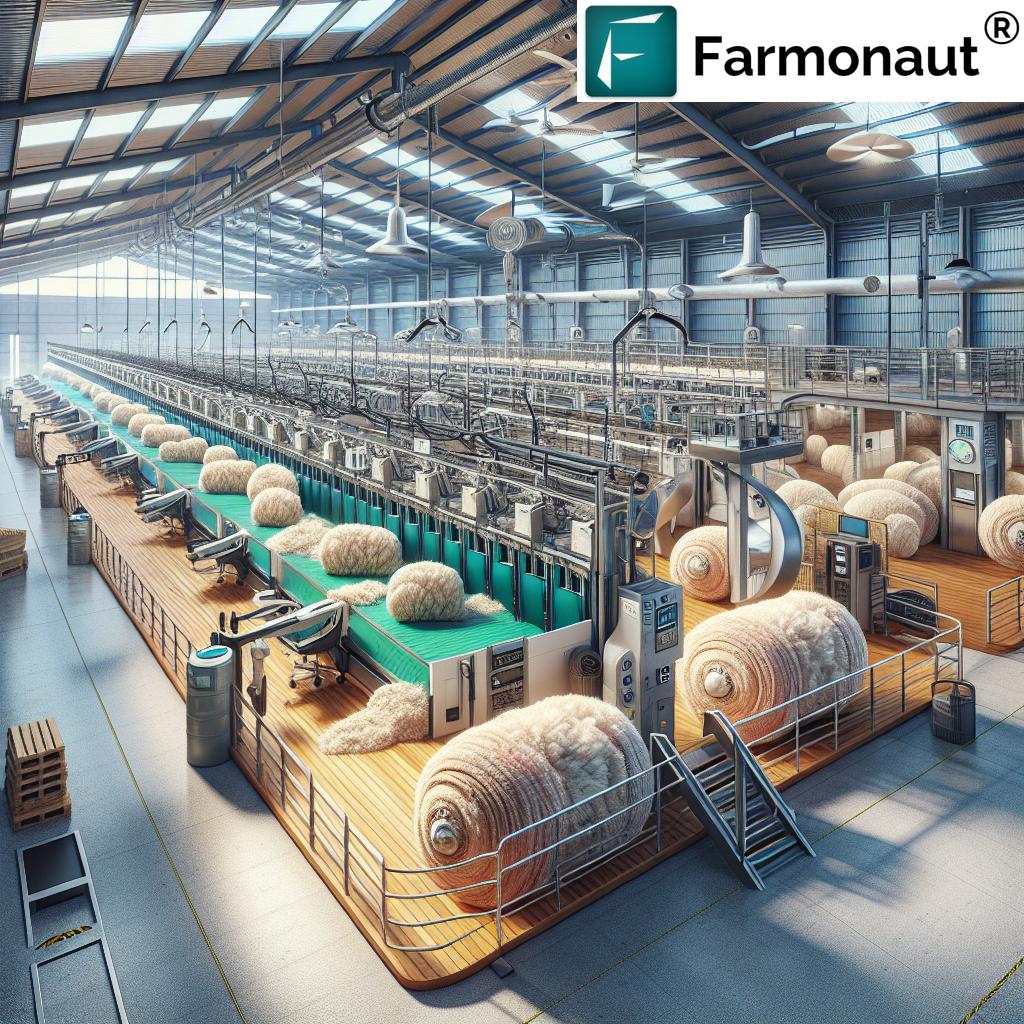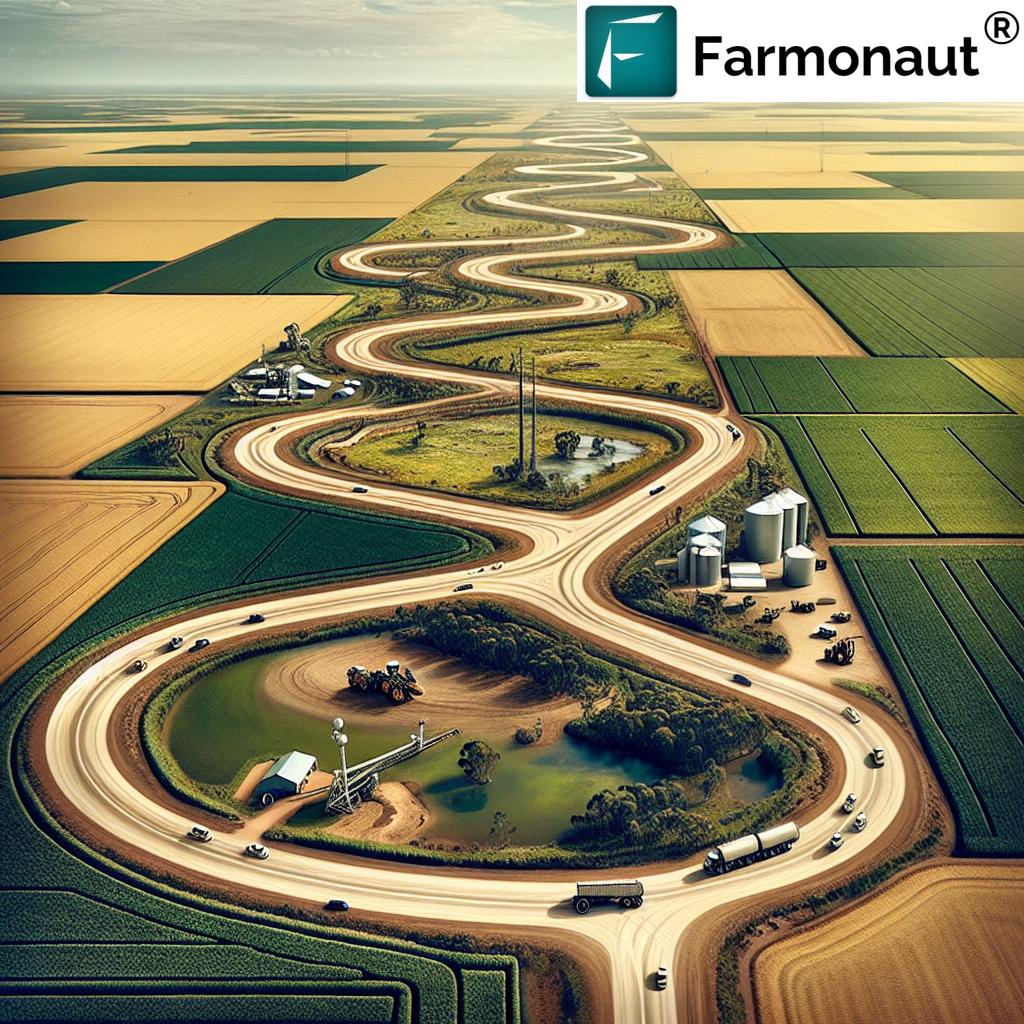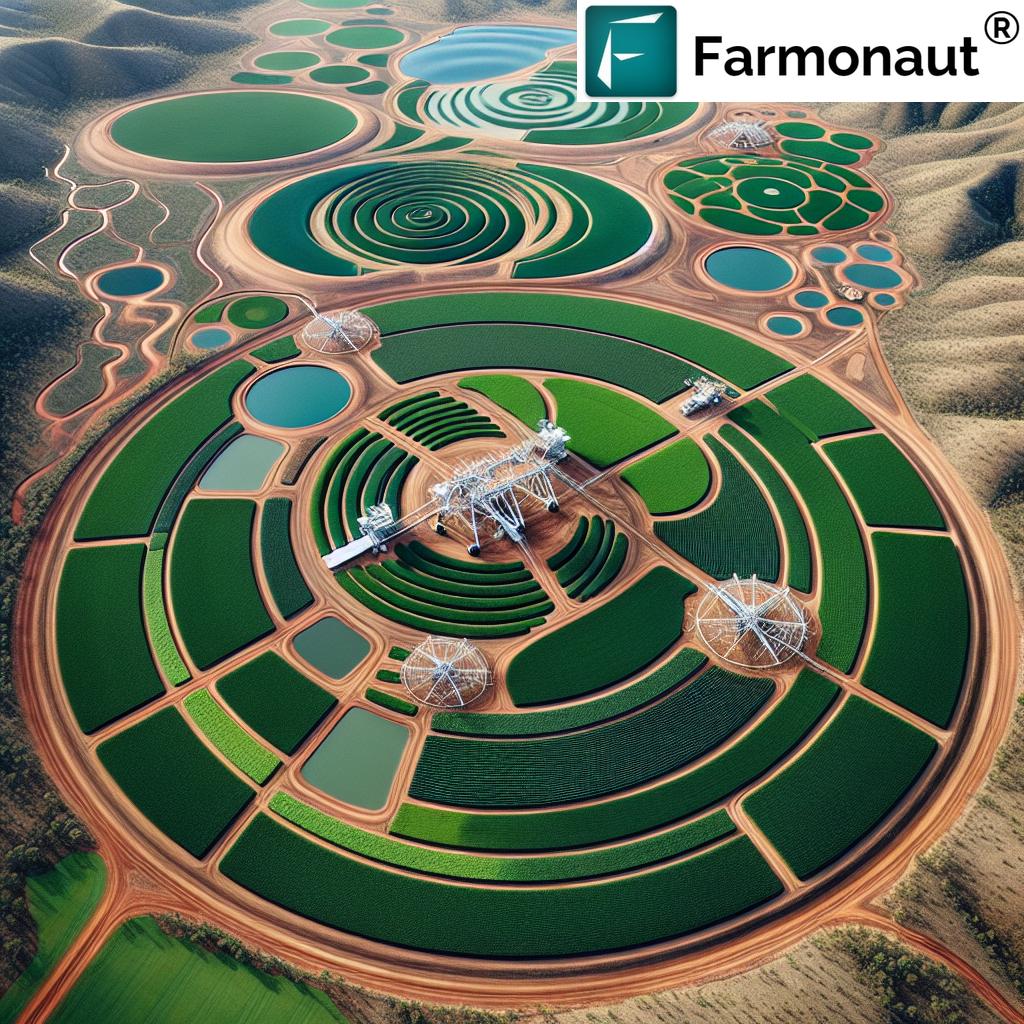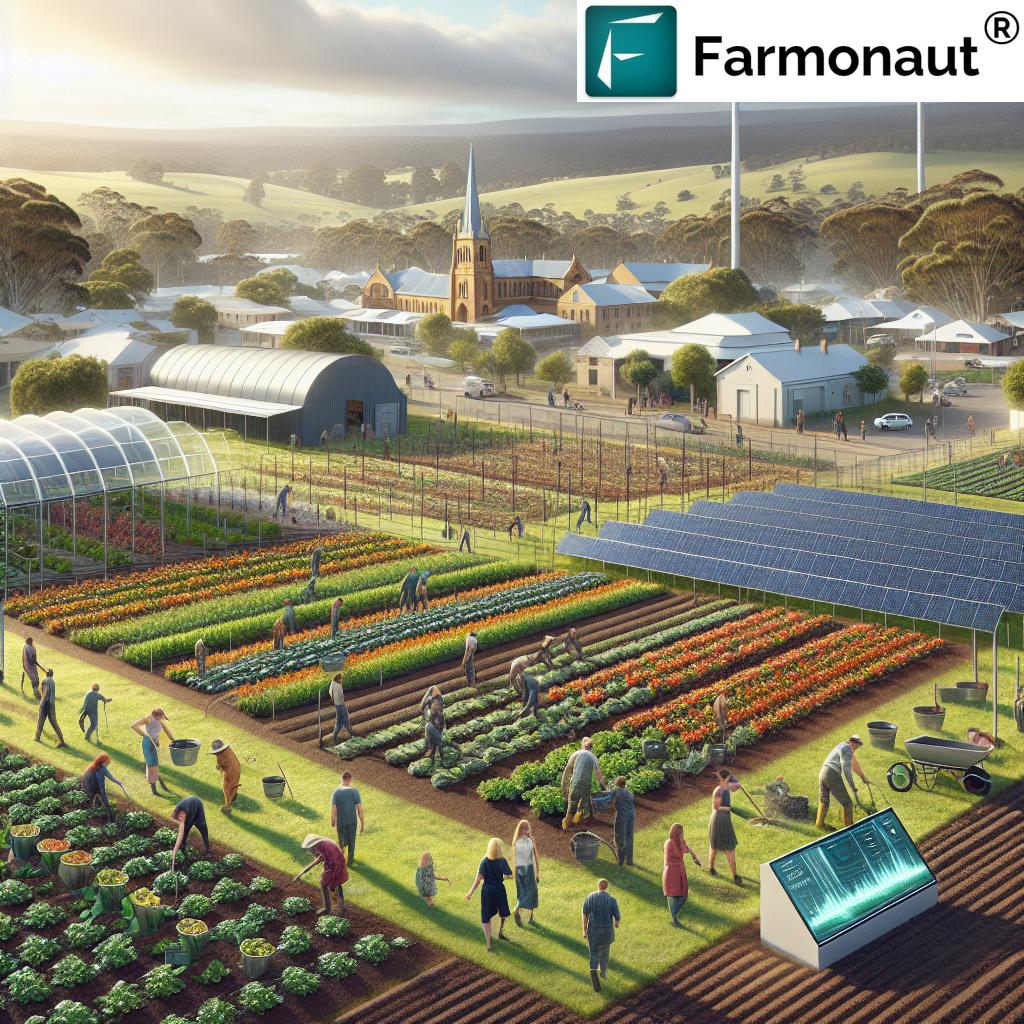Shearing Shed Innovation: 7 Powerful Advances in Australia
Table of Contents
- Summary: The Role of Shearing Sheds in the Sheep Farming Industry
- Historical Significance and the Evolution of Shearing Sheds
- Modern Shearing Shed Design & Architecture
- Technological Integration: The Heart of Shed Innovation
- Sheep Shearing Safety and Worker Welfare
- Sustainable Farming Practices in Shearing Sheds
- Key Innovations in Australian Shearing Sheds: Evolution, Impact, and Estimated Adoption
- Cultural & Community Impact: Beyond Wool Production
- Farmonaut: Enabling Data-Driven, Efficient Wool Production
- FAQ: Shearing Shed Design, Wool Processing Systems & Sheep Shearing Safety
- Conclusion: The Future of Shearing Shed Innovation
Summary: The Role of Shearing Sheds in the Sheep Farming Industry
A shearing shed, also called a wool shed, is a specialized facility designed for the shearing of sheep, the collection and processing of wool, and the creation of baled wool ready for market distribution. These structures are integral to the sheep farming industry in Australia, providing a controlled environment that enhances efficiency, sheep shearing safety, and product quality.
Shearing sheds in Australia are more than just operational spaces. They symbolize a connection with agricultural heritage, foster community traditions, and serve as the backbone for Australia’s world-renowned wool production. Over time, advances in shearing shed design, wool processing systems, and modern safety features have turned these facilities into high-performing, worker-friendly, and technologically advanced hubs.
In this comprehensive blog post, we explore the historical evolution, architectural innovations, technological integration, safety programs, and sustainability practices shaping modern shearing sheds. Our focus highlights the seven most powerful advances that have driven efficiency, productivity, and safety throughout the industry.
Historical Significance and the Evolution of Shearing Sheds
The origins of shearing sheds trace back to the early days of sheep farming, particularly in Australia—one of the world’s wool powerhouses. Farmers initially constructed rudimentary buildings to protect their sheep from the elements during the intensive annual shearing period. Over time, as the economic and cultural importance of wool as a commodity grew, these sheds evolved into sophisticated buildings, with specialized features for shearing, wool handling, and bale storage.
Shearing sheds are now iconic symbols of Australia’s agricultural heritage. Historically, their design and construction set the foundation for modern efficiency and established standards for worker safety. The heritage and cultural role of the shearing shed remains woven into the fabric of rural communities, with many historic sheds restored as heritage sites—testimony to the evolution and resilience of the Australian wool industry.
Timeline of Key Milestones in Shearing Shed Evolution
- Early 1800s: Simple slab sheds constructed with available materials for basic sheep protection.
- Late 19th Century: Timber-framed sheds, expanding in size with the onset of large-scale sheep stations in Australia.
- 20th Century: Introduction of galvanised iron roofing, dedicated wool rooms, and expansion of mechanized equipment.
- Late 20th to 21st Century: Modern shearing sheds built with advanced wool processing systems, ventilation, lighting, safety systems, and automated operations to support large-scale, efficient wool production.
The evolution of shearing sheds reflects broader themes in Australian agriculture—innovation, adaptation, and the drive toward maximizing value from every kilogram of wool produced.
Modern Shearing Shed Design & Wool Shed Architecture
Modern wool shed architecture draws on a range of factors, including climate, scale of operations, and technological advancements. The goal: to build facilities that improve efficiency, safety, and wool quality, while minimizing environmental impact and preserving the well-being of workers and livestock.
- Space & Layout: Adequate space is essential for accommodating shearers, wool handlers, support staff, and the sheep themselves. Key areas include shearing boards, wool tables, storage areas for equipment, and movement corridors designed for safe and efficient operations.
- Ventilation & Lighting: Proper ventilation in shearing sheds ensures a comfortable working environment—regulating temperature and humidity, which is crucial for both wool quality and staff comfort. Natural lighting is maximized to reduce electricity consumption, while high-quality artificial lights provide even illumination during poor daylight conditions or after dusk.
- Safety Features: Modern shearing sheds incorporate non-slip flooring, guard rails, clear walkways, and emergency stop controls for machinery. These are integral in preventing accidents and ensuring worker safety.
Australian shearing shed architectural design has adapted to the diverse Australian climate. Whether sheds are located in the temperate south, drier inland regions, or humid east, climate-specific considerations (such as insulation, shed orientation, and storm drainage) underpin every aspect of design.
Key Design Considerations for Efficient Wool Production
- Accommodating Workflow: Sheds are designed to accommodate the flow from sheep pen entrance to shearing boards, then wool tables, grading/skirting stations, and finally to bale presses and equipped storage.
- Animal Welfare: Well-designed pens, raceways, and holding areas minimize sheep stress and ensure humane handling.
- Climate Resilience: Features such as raised floors and vented eaves protect against flooding and overheated working conditions.
- Flexible, Modular Layouts: For different flock sizes and multi-purpose use—enhancing space efficiency and operational flexibility.
- Lighting & Visual Safety: Strategic use of skylights and LED lighting creates a safe and pleasant workspace, reducing eye strain and improving productivity during the shearing process.
For a deep dive into optimizing shearing shed design for efficient wool production and livestock management, see our extensive guide on Farmonaut’s Educational Resources.
Modern Features Streamlining Operations in Australian Shearing Sheds
- Non-slip Flooring: Prevents animal and worker slips—improving safety and productivity.
- Shearers’ Board Ergonomics: Specialized platform heights and surfaces reduce fatigue and risk of repetitive strain injuries.
- Rapid Wool Collection: Efficient movement systems (e.g., conveyor tables) support quick removal and sorting of freshly shorn wool, preserving quality before processing.
- Integrated Machine Controls: Safety interlocks and easy-to-reach controls reduce machinery accidents, enabling rapid shut offs when needed.
This blend of design precision, environmental management, and structural safety is at the core of modern shearing shed architecture in Australia.
Are you an agribusiness innovator? Integrate Farmonaut’s Satellite & Weather Data API into your own systems for real-time agricultural insights. Explore our full API Developer Docs for more details.
Achieve sustainability goals with Farmonaut’s Carbon Footprinting solutions—track, analyze, and reduce emissions across sheep farming operations.
Technological Integration: The Heart of Shearing Shed Innovation
The transformation of the shearing shed has accelerated with the infusion of technology—from automated systems to smart digital tools. These technologies underpin new levels of efficiency, wool quality, and safety that were previously unimaginable.
Automation and Digital Tools Shaping the Future
- Automated Sheep Counting: Modern facilities employ automated gateways that count sheep as they flow through pens and shearing boards. This delivers precise inventory data and supports both manual and digital livestock management systems.
- Climate Control Technologies: Sensors monitor temperature and humidity, automatically adjusting ventilation and cooling/heating elements to maintain optimal working and storage conditions.
- Digital Wool Classification: Wool clips are assessed using digital tools that measure fiber diameter, length, and quality with high accuracy. This helps wool handlers and marketers maximize yield and price in wool processing systems.
For large-scale sheep farms and agribusinesses, these advances have streamlined operations, reduced resource waste, and safeguarded the health of both workers and livestock.
Leading textile corporations rely on Farmonaut’s blockchain-based traceability solutions to verify wool origin and ensure rock-solid supply chain transparency in the global wool and textile industry.
Impactful Technological Advancements in Wool Sheds
- Automated Wool Presses: Revolutionized wool baling operations—compressing fleece into uniform bales faster, safer, and with less manual effort than ever before.
- Integrated Bale Storage Systems: Mechanized storage allows quick transfer of finished bales and improved inventory management.
- Data-Driven Decision Making: Integration of cloud-based management tools and IoT sensors for real-time monitoring of shed activity, productivity, and environmental variables.
-
Energy-Efficient Installations: Use of solar panels and low-energy infrastructure reduces operational costs and supports Australia’s sustainability objectives.
Tip: Learn more about sustainable shed evolution in Australia.
Global Impact: These technological advancements in wool sheds ensure that Australia retains its global leadership in efficient wool production, catering not just to local but also to lucrative export markets.
Sheep Shearing Safety and Worker Welfare
Ensuring safety in shearing sheds is a core priority for modern farming operations. The physical nature of shearing, risk of machinery accidents, and the fast pace of seasonal work make comprehensive safety strategies non-negotiable.
Essential Safety Features in Modern Shearing Sheds
- Guard Rails & Non-Slip Surfaces: Reduce trip and fall injuries, particularly in high-traffic areas and during rapid sheep movement.
- Emergency Stop Controls: Clearly marked, accessible controls allow for instant shutdowns of equipment—crucial to prevent major accidents.
- Cohesive Layouts: Separation between shearing boards and wool preparation areas decreases congestion and the risk of collisions between workers and livestock.
- Clear Signage: Labels for hazardous zones, exits, equipment, and procedures, supporting both staff and visitor safety.
The SafeSheds Program delivers industry-leading resources on best practice safety measures, offering self-assessment tools and guides to help woolgrowers upgrade existing sheds or plan safe new facilities.
Training and Education: The Backbone of Worker Safety
- Professional Development: Courses like the Certificate III in Shearing by TAFE Australia focus on practical training, safety protocols, and modern shearing techniques.
- On-site Induction: Every worker is briefed on shed layout, emergency procedures, and operational hazards prior to commencing work.
- Ongoing Supervision: Experienced shed managers oversee daily operations, mentoring newer staff and ensuring that safety procedures are consistently upheld.
Sheep shearing safety is central to both productivity and worker retention, creating a positive environment where skilled staff can thrive—and injuries are minimized.
Protect your farming investments with Farmonaut’s crop loan & insurance verification tools. Farmers and financial institutions alike benefit from satellite-based verification that boosts trust and speeds up claims processing.
Sustainable Farming Practices in Shearing Sheds
Today, sustainability in wool production and shed operations goes hand-in-hand with business success. Environmental stewardship is both a market expectation and an essential foundation for future generations of Australian sheep farmers.
- Solar Panels: Many modern shearing sheds incorporate solar installations to power machinery, reduce operating costs, and shrink their carbon footprint.
- Rainwater Harvesting: Roof catchments and storage tanks collect and recycle water for cleaning, animal drinking, and landscaping.
- Low-Energy Lighting: Use of LED fixtures and design maximizes daylight intake, minimizing electricity use.
- Eco-friendly Materials: Selection of sustainable timber, recycled steel, and low-toxicity paints in shed construction.
Incorporating these sustainable farming practices not only reduces the environmental impact of the sheep farming industry but can also enhance the brand reputation of growers in global wool markets.
For a practical expansion into large-scale, multi-site farm management with integrated sustainability analytics, check out the Farmonaut Agro Admin App.
Key Innovations in Australian Shearing Sheds: Evolution, Impact, and Estimated Adoption
Below is a comparative table summarizing the seven most powerful advances in Australian shearing sheds. Each innovation reflects a leap in efficiency, safety, design, or sustainability—supporting both woolgrowers and the broader community.
| Innovation Name | Year Introduced (Est.) | Description | Impact on Wool Yield (% Increase) | Impact on Shearing Speed (% Improvement) | Estimated Adoption Rate | Contribution to Safety |
|---|---|---|---|---|---|---|
| Modular Shed Layouts | 1980s | Flexible, scalable designs to optimize space, workflow, and accommodate variable flock sizes. | +10–12% | +15–20% | ~75% | Reduces congestion, improves worker flow. |
| Automated Wool Presses | 1990s | Electro-hydraulic presses for swift, uniform wool bale creation, lowering labor demands. | +5–8% | +18–25% | 60–70% | Lowers risk of muscle/strain injuries. |
| Ventilation Improvements | 2000s | Advanced vented eaves, fans, and automatic climate controls for regulating temperature and humidity. | +6–10% | +8–12% | ~85% | Lowers heat stress risk in workers and sheep. |
| Advanced Shearing Equipment | 2000s | Ergonomic handpieces, pneumatic lift shearing stands, and electronic tally counters. | +8–12% | +25–30% | 70–80% | Reduces RSI and operator fatigue. |
| Digital Monitoring & Automation | 2010s | Sensors, cameras, IoT systems for tracking shed conditions, sheep counts, and workflow analytics. | +5–8% | +10–18% | ~55% | Immediate detection of hazards/maintenance. |
| Ergonomic Flooring and Walkways | 1990s–2000s | Shock-absorbing, non-slip materials for improved safety and animal movement. | +6–9% | +8–14% | ~80% | Significantly reduces trip & slip injuries. |
| Comprehensive Safety Training Initiatives | 2010s | Industry-wide programs, formal certifications, and digital training modules for workers. | +2–5% | +4–7% | ~90% | Reduces machinery & personal injury risk. |
Increase market trust in your shed’s wool bale distribution using Farmonaut’s Product Traceability for authentic, blockchain-secured wool tracking from shed to retailer.
Cultural & Community Impact: Beyond Wool Production
The shearing shed transcends its operational role as a facility for wool production. In rural Australia, these sheds serve as community hubs—regularly hosting regional events, shearing competitions, family gatherings, and seasonal celebrations after harvest. This communal aspect preserves agricultural tradition and strengthens the sense of identity within sheep farming regions.
Thanks to the historical significance of shearing sheds, many older sheds are now registered as heritage sites, with conservation funding supporting their restoration and public education roles. Find out more about historical sites and agricultural heritage.
- Workshops and field days at shearing sheds encourage knowledge exchange and industry innovation.
- Preserved historical shearing sheds enable tourists and students to learn about the evolution of Australian agricultural practices.
- Ongoing conservation efforts highlight the environmental and cultural impact of wool production in rural Australia.
In the fabric of the Australian sheep farming industry, the shed remains not just a building—but a living piece of heritage, transition, and community pride.
Start smarter farm planning using Farmonaut’s Crop, Plantation, and Forest Advisory tools. Our platform is built for broad-acre and plantation farmers looking to optimize yields with the latest satellite and AI insights.
Farmonaut: Enabling Data-Driven, Efficient Wool Production
At Farmonaut, we recognize the unique challenges and opportunities within Australia’s wool industry. That’s why we provide agricultural technology solutions that empower sheep farmers, agribusinesses, cooperatives, and supporting organizations to make data-driven, resource-smart decisions.
-
Satellite Crop Health Monitoring:
Our multispectral analysis delivers insights on pasture and forage quality, guiding optimal grazing decisions and ensuring healthier, high-yielding flocks to enter the shearing shed. -
AI-Driven Advisory:
With Jeevn AI, we offer real-time guidance on everything from climate outlooks to resource allocation, reducing risk and sustaining operational excellence. -
Blockchain Traceability:
Our transparent product tracking helps shed operators and wool processors trace every bale from flock to retailer, supporting global best practices in commodity authentication. -
Fleet Management:
Using our centralized tool, agribusiness leaders can optimize transport and equipment use during peak shearing seasons, ensuring timely collection and safe, traceable distribution of wool bales.
Explore Farmonaut’s Fleet Management solutions—reduce overheads, ensure safety, and maximize returns on machinery. -
Carbon Footprinting:
Our platform delivers easy-to-access, real-time data on the environmental impact of your farming operations—inclusive of shed activities—to ensure compliance and progress on sustainability targets.
Our mission is to make precision agriculture affordable and accessible, supporting the future of efficient, responsible, and community-centered wool production.
FAQ: Shearing Shed Design, Wool Processing Systems & Sheep Shearing Safety
What is the purpose of a shearing shed?
A shearing shed (wool shed) is a specialized facility designed for the shearing of sheep, collection and processing of wool, and preparation of wool bales for market distribution. It provides a controlled, safe environment for efficient and high-quality wool production.
What are the key advances in modern shearing shed design?
Major advances include modular layouts, automated wool presses, climate control and ventilation, energy-efficient lighting, ergonomic flooring, and the integration of digital monitoring systems—all focused on improving efficiency, safety, and sustainability.
How do technological advancements impact wool production?
Automated systems, digital monitoring, and advanced shearing equipment have increased the speed of operations, improved wool quality, and reduced injuries among workers—resulting in higher yields and better profitability for wool growers.
What safety measures are essential in shearing sheds?
Essential safety measures include non-slip flooring, guard rails, emergency stop controls, clear signage, ongoing worker training, and the separation of livestock movement paths from machinery and worker areas.
How do shearing sheds support sustainable farming practices?
Many modern shearing sheds use solar panels, rainwater harvesting, recycled building materials, and low-energy lighting to minimize environmental impact and improve the overall sustainability of sheep farming operations.
Conclusion: The Future of Shearing Shed Innovation
Australian shearing sheds stand as beacons of progress in the global sheep farming industry. Driven by historical evolution, cutting-edge architectural design, technological integration, safety programs, and sustainable initiatives, these facilities not only enable efficient wool production but also safeguard rural heritage and community well-being.
The ongoing adoption of automation, digital tools, and eco-friendly practices promises to deliver even greater efficiency, safety, and product quality in the years ahead—ensuring Australia remains a leader in world-class sheep and wool operations.
For Australian woolgrowers, farm managers, and agribusiness leaders, embracing these shearing shed innovations is key to securing sustained commercial success, responsible land stewardship, and the enduring cultural value of the Australian shed.
To support your journey in smarter farming, explore Farmonaut’s suite of precision agriculture, traceability, and sustainability tools, available on web and mobile platforms today.

















